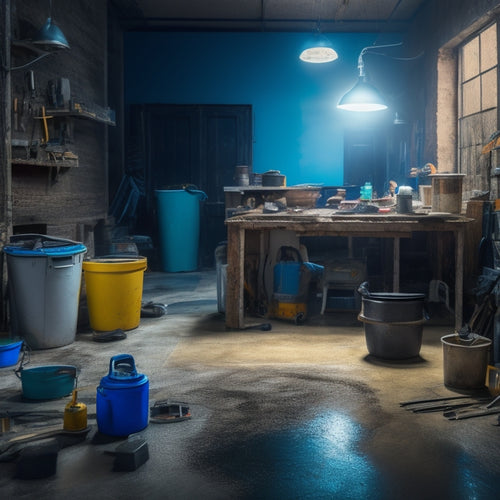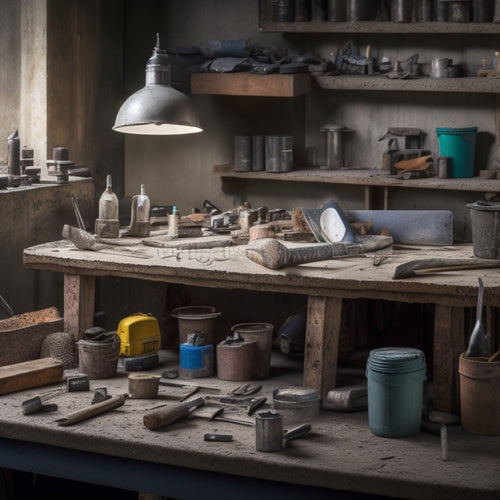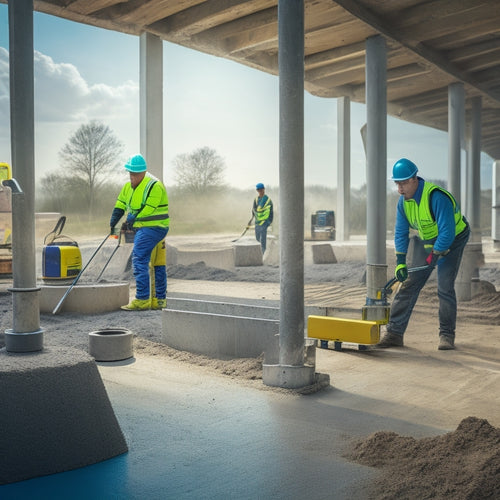
Top Tools for Plastering Stamped Concrete Walls
Share
When plastering stamped concrete walls, you'll need a range of specialized tools to achieve professional-looking results. Start with trowels for texture control, selecting the right grip style and material for your project. Plastering hawks facilitate smooth application and transport, with material choices affecting durability. Edgers guarantee clean lines, with steel or rubber options for sharp edges or curves. Floats provide a smooth finish, with weight and material density considerations. Darby tools, putty knives, and specialty tools for stamped patterns complete your arsenal. By selecting the right tools, you'll be well on your way to achieving a flawless finish - and there's more to learn about each of these essentials.
Key Takeaways
- The right trowel choice, including pointing, finishing, and grip styles, impacts the finish quality of plastered stamped concrete walls.
- Plastering hawks, available in aluminum, stainless steel, and fiberglass, facilitate smooth plaster application and transport, with size and material affecting durability.
- Edgers, including steel and rubber options, are crucial for clean lines, with considerations for edge design, width, and handle ergonomics.
- Floats, such as bull, fresno, and darby floats, are essential for smooth finishes, with weight, material density, and handle comfort affecting performance.
- Specialty tools, including pattern stamps, texture rollers, brooms, and brushes, help create unique finishes and textures on plastered stamped concrete walls.
Essential Trowels for Texture Control
When you're working with plastering concrete walls, achieving the desired texture is crucial, and that's where essential trowels come into play. Mastering texture application techniques relies heavily on the type of trowel you use and how you grip it. The right trowel can make all the difference between a smooth, even finish and a rough, uneven one.
For instance, a pointing trowel is ideal for applying smooth, fine textures, while a finishing trowel is better suited for creating more intricate, decorative patterns.
The way you hold your trowel also affects the final result. A "hammer grip" style, where you hold the trowel like a hammer, is great for applying heavy textures, while a "pencil grip" style, where you hold the trowel like a pencil, is better for more delicate work.
With the right trowel and grip style, you'll be able to achieve the perfect texture for your concrete wall.
Selecting the Right Plastering Hawk
After mastering the art of texture control with the right trowel and grip style, you're ready to focus on the next critical component of plastering concrete walls: the plastering hawk. This tool is your right-hand man, helping you transport and apply plaster efficiently.
But with so many options out there, how do you choose the right one?
First, consider the hawk material types. You've got your standard aluminum hawks, which are lightweight and easy to maneuver. Then there are stainless steel hawks, which offer more durability and resistance to corrosion.
And let's not forget about the fancy-schmancy fiberglass hawks, which boast superior strength-to-weight ratios.
When it comes to hawk size, bigger isn't always better. A larger hawk may hold more plaster, but it can be cumbersome and difficult to handle. On the other hand, a smaller hawk might be more agile, but it may require more frequent refills.
A good rule of thumb is to opt for a hawk that's around 12-18 inches in length – this usually strikes a nice balance between capacity and maneuverability.
Best Edgers for Clean Lines
How precisely do you want those clean lines on your concrete walls? It's an essential question, as edgers can make all the difference between a professional-looking finish and a sloppy one. The right edger will help you achieve those razor-sharp lines that elevate your stamped concrete walls from bland to grand.
When it comes to edger materials, you've got options. From sturdy steel to flexible rubber, each material has its strengths and weaknesses. Steel edgers are great for creating sharp, defined edges, while rubber edgers are better suited for curved or irregular surfaces.
Here are three key considerations when choosing an edger for clean lines:
-
Edge design: Will you be working with straight lines, curves, or a mix of both? Choose an edger that can adapt to your design requirements.
-
Edger width: A wider edger may be more efficient, but a narrower one can provide more precision. Consider the scale of your project when selecting an edger width.
-
Handle ergonomics: A comfortable, well-balanced handle can make all the difference in reducing fatigue and improving your overall edging experience.
Must-Have Floats for Smooth Finish
When selecting a float for plastering concrete walls, you'll want to take into account factors like material, size, and handle type to guarantee a smooth finish.
Proper maintenance is also vital, as a well-maintained float will help you achieve consistent results and extend its lifespan.
Float Selection Criteria
Your float selection is critical to achieving a smooth, even finish on your concrete walls. You want to make sure you're choosing the right tool for the job, and that means evaluating the type of float and its material.
There are several float types to choose from, including bull floats, fresno floats, and darby floats. Each has its own strengths and weaknesses, and the right one for you'll depend on the specific needs of your project.
When it comes to float materials, you'll want to assess the following:
-
Weight: A heavier float provides more pressure, which can be helpful for larger areas, but may be difficult to manage for smaller projects.
-
Material density: A denser float material will provide a smoother finish, but may be more prone to wear and tear.
-
Handle type: A comfortable, ergonomic handle can make a big difference in your productivity and overall experience.
Float Maintenance Essentials
With the right float in hand, you're ready to focus on maintaining it to achieve a smooth, even finish on your concrete walls. Floating is a critical step in the plastering process, and using the wrong float or neglecting maintenance can lead to uneven surfaces, air pockets, and a whole lot of frustration.
When it comes to float maintenance, you need to understand the different types of floats and their specific requirements. Bull floats, for instance, have a larger surface area and are perfect for applying a lot of pressure, but they can be heavy and hard to maneuver.
On the other hand, darby floats are lighter and more agile, making them ideal for smaller areas and detail work.
Regardless of the float type, regular cleaning and maintenance are essential. Remove any excess concrete or debris after each use, and store your floats in a dry place to prevent rust or corrosion.
You should also inspect your floats regularly for signs of wear and tear, replacing them as needed. By following these simple float maintenance essentials, you'll be well on your way to achieving a smooth, professional-looking finish on your concrete walls.
Achieving Smooth Edges
Achieving smooth edges requires the right combination of floats and techniques. You'll need to master the art of edge detailing to create a seamless finish on your stamped concrete walls.
The key is to use the right float for the job, and we're not just talking about any float – we're talking about a high-quality, smooth-finish float specifically designed for edge work.
When it comes to smoothing techniques, you'll want to focus on the following:
- Hold the float at a 45-degree angle to the wall, using long, sweeping strokes to feather the edges.
- Use a gentle touch, applying just enough pressure to smooth out the concrete without creating swirl marks or bubbles.
- Work in small sections, maintaining a wet edge to prevent the concrete from setting too quickly and creating an uneven finish.
Top-Notch Darby Tools for Finishing
When you're looking to achieve a flawless finish on your concrete walls, you'll want to choose a darby tool that suits your specific needs.
You'll need to evaluate the selection of darby tools available, taking into account the material of the handle, which can range from lightweight aluminum to durable fiberglass.
Additionally, you'll want to think about the edge options, which can include rounded, square, or even notched edges, each designed to tackle specific finishing tasks.
Darby Tool Selection
Select a darby tool that's right for the job, and you'll be smoothing out concrete walls like a pro. With so many darby tool types out there, it's important to know what you need for your specific project.
You'll want to take into account the size and shape of the wall, the type of concrete, and the desired finish.
For instance, a 24-inch darby tool is perfect for large, open areas, while a 12-inch darby is better suited for smaller, more intricate spaces.
And, when it comes to darby application techniques, you'll want to choose a tool that allows for smooth, even strokes.
- Look for darby tools with rounded edges to prevent scratching the concrete
- Opt for tools with an ergonomic handle to reduce fatigue
- Think about a darby tool with adjustable handles for customized control
Darby Handle Materials
Your choice of darby handle material can greatly impact the overall performance and durability of your tool. When it comes to darby handles, you've got two main options: aluminum and wood.
An aluminum darby handle is a popular choice among pros, and for good reason. It's lightweight, corrosion-resistant, and can withstand the rigors of heavy use. Plus, it's easy to clean and maintain, which is a major plus when you're working with messy plaster.
On the other hand, a wooden darby handle offers a more traditional feel and can provide a bit more grip, which is helpful when you're working with particularly stubborn concrete. However, wood handles can be prone to warping or cracking if not properly maintained, so be prepared to put in some TLC.
Ultimately, the choice between aluminum and wood comes down to personal preference and your specific needs on the job site. Just remember, a high-quality darby handle is essential for achieving a smooth, even finish.
Darby Edge Options
Equipped with a high-quality darby handle, it's time to focus on the cutting edge - literally.
The darby edge is where the magic happens, and you've got options to suit your finishing style. You'll find darby design variations that cater to different darby tool applications and concrete wall requirements.
When it comes to edge options, you're not limited to a one-size-fits-all solution.
Consider the following:
- Flexible edge: Ideal for curved or irregular surfaces, this edge conforms to the wall's shape, ensuring a smooth finish.
- Rigid edge: Perfect for straight edges and large, flat areas, this edge provides a crisp, clean finish.
- Notched edge: Designed for textures and patterns, this edge creates a unique, decorative finish.
Choosing the Perfect Putty Knife
As you prepare to tackle a plastering project, a putty knife becomes an indispensable extension of your hand, scraping, spreading, and smoothing its way through hours of meticulous labor.
But not all putty knives are created equal, and choosing the perfect one can make all the difference in your project's success.
You'll find putty knives in various types, including flexible, stiff, and semi-flexible, each designed for specific tasks. Flexible putty knives are ideal for spreading and smoothing large areas, while stiff putty knives are better suited for scraping and removing old plaster. Semi-flexible putty knives offer a balance between the two.
When it comes to putty knife materials, you'll typically find them made from stainless steel, high-carbon steel, or flexible materials like silicone or rubber. Stainless steel putty knives are durable and resistant to corrosion, while high-carbon steel putty knives are stronger and more flexible.
Flexible materials, on the other hand, provide added comfort and flexibility during extended use. By selecting the right putty knife type and material for your project, you'll be well on your way to achieving a smooth, professional finish.
Specialty Tools for Stamped Patterns
During the final stages of your plastering project, you'll likely encounter the need to create intricate, stamped patterns on your concrete walls.
To achieve these designs, you'll need specialized tools that can help you create detailed textures and patterns.
Pattern stamps and texture rollers are must-haves for creating realistic stone, brick, or wood patterns. These tools come in various shapes, sizes, and materials, each designed to produce a specific effect.
For instance, you can use a wood-grain texture roller to create a realistic wood pattern or a stone-pattern stamp to mimic the texture of natural stone.
Some essential specialty tools to take into account:
- Pattern stamps with interchangeable inserts for versatility
- Texture rollers with adjustable handles for ease of use
- Stamp mats with built-in grids for precise pattern alignment
Finishing Touches With Brooms and Brushes
Pick up your broom or brush to add the final flourishes to your freshly plastered concrete walls. You're in the home stretch, and these tools will help you achieve the desired finish.
When it comes to broom techniques, you'll want to use a stiff-bristled broom to create a textured, rough-hewn look. Hold the broom at a 45-degree angle and sweep it across the wall in smooth, even strokes.
For a more subtle finish, try using a soft-bristled broom or a broom with synthetic bristles.
If you're going for a more refined look, break out the brushes. A wire brush will give you a more aggressive, scratch-like finish, while a nylon brush will produce a smoother, more even finish.
Experiment with different brush finishes to find the one that suits your design aesthetic. Remember to work in small sections, as the plaster can set quickly.
With the right broom techniques and brush finishes, you'll be able to achieve a beautiful, professional-looking finish that will make your stamped concrete walls stand out.
Frequently Asked Questions
Can I Use a Regular Trowel for Plastering Stamped Concrete Walls?
You can't just grab any trowel for plastering stamped concrete walls, friend! You'll need specialized trowel types, like a pool trowel or a finishing trowel, to master those intricate plastering techniques and achieve a flawless finish.
How Often Should I Clean and Maintain My Plastering Tools?
Think of your tools as a high-maintenance significant other - they need regular attention to perform well. Clean and maintain them daily, storing them in a dry place, to prevent rust and guarantee a smooth plastering experience.
What Is the Ideal Temperature for Plastering Stamped Concrete Walls?
When you're perfecting your plastering techniques, keep in mind that ideal temperatures range from 50°F to 70°F (10°C to 21°C), as extreme temperatures can affect workability, setting times, and final appearance – so, don't let the weather get in the way of your masterpiece!
Can I Use a Power Washer to Clean Stamped Concrete Walls?
When cleaning stamped concrete walls, you'll want to avoid power washers, as they can damage the surface; instead, opt for gentler cleaning techniques and adjust pressure settings to prevent damage, saving you from a world of costly repairs.
How Do I Prevent Color Inconsistencies in Stamped Concrete Finishes?
You'll avoid color inconsistencies in stamped concrete finishes by precisely measuring and mixing color hardeners, then applying a consistent sealant coat; remember, it's all about the math, not magic, so calculate and calibrate for a flawless, factory-fresh finish!
Conclusion
You've mastered the art of plastering stamped concrete walls, and now your canvas is ready to be transformed into a masterpiece. With these high-quality tools in your arsenal, you'll be able to add texture, depth, and visual appeal to your creations. Remember, the right tools are like a painter's brushes - they bring your vision to life. As you put the finishing touches on your project, the end result will be a true work of art that will leave a lasting impression.
Related Posts
-

Essential Tools for Epoxy Concrete Floor Repair
You'll need a thorough arsenal of specialized tools to guarantee a successful epoxy concrete floor repair. Floor prep...
-

Top Tools for Concrete Repair Success
When it comes to concrete repair success, you'll need a well-stocked toolkit with essential hand tools like trowels, ...
-

What Tools Ensure Precise Concrete Leveling Results
You need a range of specialized tools to achieve precise concrete leveling results. Laser leveling instruments provid...


